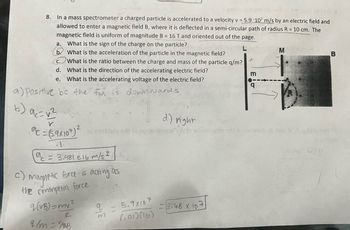Question
how do i do part E of this question? this is a non graded practice worksheet

Transcribed Image Text:8.
In a mass spectrometer a charged particle is accelerated to a velocity v = 5.9 107 m/s by an electric field and
allowed to enter a magnetic field B, where it is deflected in a semi-circular path of radius R = 10 cm. The
magnetic field is uniform of magnitude B = 16 T and oriented out of the page.
a. What is the sign of the charge on the particle?
b. What is the acceleration of the particle in the magnetic field?
What is the ratio between the charge and mass of the particle q/m?
d. What is the direction of the accelerating electric field?
e.
What is the accelerating voltage of the electric field?
a) positive be the fu is downwards
b) a₁ = √²
Y
c=(5.9x107) lomaly sit to
a
c = 3.481 e 16 m/s ²
c)
magnetic force is acting as
the centripetal force
33/3²
q (VB) = my ²
9/m=YB
q
5.9x107
(.01)(16)
d) right
cyno
=3.68 x 107
m
q
M
Fra sri 9 m19156 ns VS
B
pisos
Expert Solution
This question has been solved!
Explore an expertly crafted, step-by-step solution for a thorough understanding of key concepts.
This is a popular solution
Trending nowThis is a popular solution!
Step by stepSolved in 2 steps with 1 images

Knowledge Booster
Similar questions
- how would you do this? this is a non graded practice worksheetarrow_forwardPlease help me understand the concept on this practice problem. Thanksarrow_forwardphysics homework problem that doesn’t have an example type in the book. I do not earn points for the homework in my class, the problems are just practice for my quiz.arrow_forward
arrow_back_ios
arrow_forward_ios